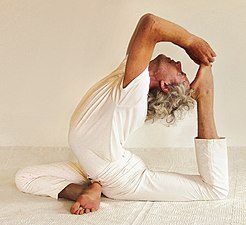Eka Pada Rajakapotasana

Eka Pada Rajakapotasana (
Etymology and origins
The name comes from the Sanskrit words "eka" (एक) meaning "one"; "pada" (पाद) meaning "foot", "rāja" (राज) meaning "king", kapota (कपोत) meaning "pigeon"[1] and āsana (आसन) meaning "posture" or "seat".[2]
The pose is described in the 20th century by two of
Description
Starting from sitting in
Variations
Of Rajakapotasana I
In Supported [King] Pigeon or Salamba Kapotasana, the rear leg is straight out and the hands are on the ground beside the hips, reducing the backbend. If comfortable, the back may be arched and the gaze directed straight upwards.[6]
In Sleeping Pigeon (or Sleeping Swan in Yin Yoga[7]), the rear leg is straight with the body and arms stretched forwards over the bent forward leg. This pose is sometimes named "Pigeon",[8] but it is a different pose from the advanced kneeling backbend of Kapotasana.[4][9][10]
In Aerial yoga, Flying Pigeon Pose is a hammock-supported variant with one foot hooked across the front of the hammock.[11]
The pose can be practised with the rear knee against a wall, the lower leg vertical with a strap around the foot, working towards the full pose. The strap is grasped with both hands, the arms reversed so that the elbows point upwards.[12]
-
In this variation, the rear foot hooks the arm on the same side.
-
Aerial yoga class practising Flying Pigeon Pose, a hammock-supported variant[11]
-
Variation with both hands grasping the rear foot
Eka Pada Rajakapotasana II, III, and IV
For Eka Pada Rajakapotasana II, the hands and the rear foot are as for Rajakapotasana I, but the sole of the front foot is on the floor in front of the hip, and the front knee is sharply bent with the knee forwards of the foot; the hips are off the ground.[13]
In Eka Pada Rajakapotasana III, the hands and the rear foot are as for Rajakapotasana I, but according to Iyengar Yoga the front knee points forwards, with the front foot and lower leg on the ground beneath the thigh.[14]
For Eka Pada Rajakapotasana IV, the hands and the rear foot are as for Rajakapotasana I, but the front foot is stretched straight forwards along the ground. The pose may be practised using props: the rear lower leg vertically up a wall, a yoga block under the sitting bones, another block if needed under the front leg, and a strap between the hands and the rear foot.[15]
See also
- Anjaneyasana, the closely related Crescent Moon pose, with the front foot on the floor and the front knee raised
- Kapotasana, Pigeon pose
References
- ^ a b "Eka Pada Raja Kapotasana". AshtangaYoga.info. Retrieved 9 April 2011.
- ISBN 978-81-7041-293-9.
- ISBN 81-7017-389-2.
- ^ ISBN 978-1855381667.
- ^ "One-Legged King Pigeon Pose". Yoga Journal. Retrieved 12 July 2022.
- ISBN 978-0-7360-6203-9.
- ^ a b "Swan". Yin Yoga. Retrieved 24 July 2019.
Similar Yang Asanas: Proud Pigeon (Rajakapotasana).
- )
- ^ a b Crandell, Jason (17 March 2016). "Master Sleeping Pigeon Pose in 4 Steps". Yoga Journal.
- ^ Rizopoulos, Natasha (16 July 2008). "The King of Hip Openers: Pigeon Pose". Yoga Journal.
- ^ a b Dortignac, Michelle (17 June 2015). "The Aerial Yoga Sequence: 9 Poses to Defy Gravity". Yoga Journal. Retrieved 4 June 2018.
- ISBN 978-0-86318-420-8.)
{{cite book}}: CS1 maint: multiple names: authors list (link - ^ Anon (5 May 2008). "One-Legged King Pigeon Pose II". Yoga Journal. Retrieved 12 October 2022.
- ^ Beaumont, Jennifer (23 January 2018). "In the Heart: Eka Pāda Rajakapotāsana III". Grand Rapids, Michigan: Light on Yoga Institute (Iyengar Yoga Center). Retrieved 12 October 2022.
- ^ Benagh, Barbara (16 March 2010). "Eka Pada Rajakapotasana IV (Bird by Bird: One-Legged King Pigeon Pose IV)". Yoga Journal. Retrieved 12 October 2022.


![Swan Pose in Yin Yoga is similar to Salamba Kapotasana.[7] For the 'sleeping' variant, the body is reclined forwards over the bent leg.[9]](http://upload.wikimedia.org/wikipedia/commons/thumb/4/45/IMG_0585_2--_Swan.jpg/376px-IMG_0585_2--_Swan.jpg)
![Aerial yoga class practising Flying Pigeon Pose, a hammock-supported variant[11]](http://upload.wikimedia.org/wikipedia/commons/thumb/0/07/Aerial_Yoga.jpg/354px-Aerial_Yoga.jpg)


